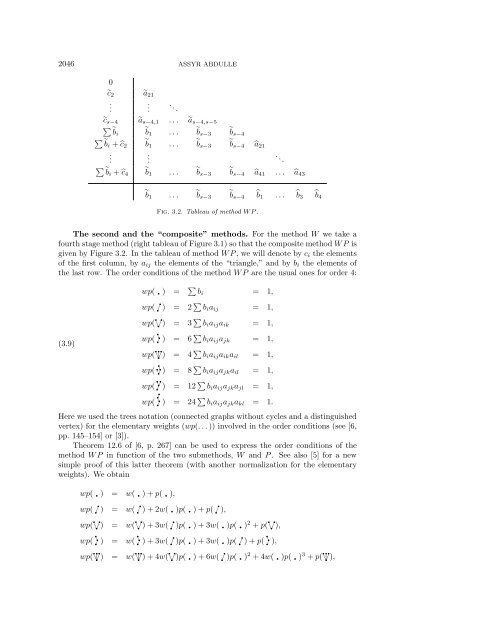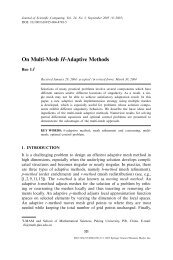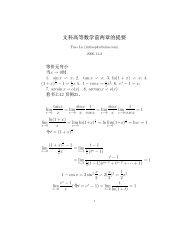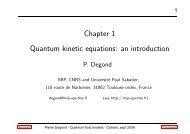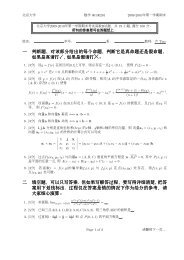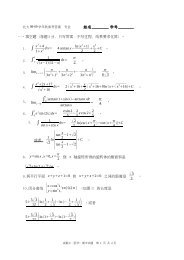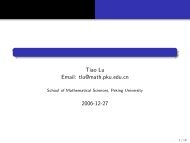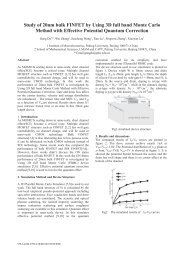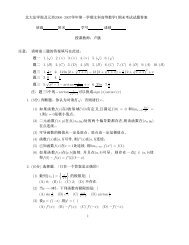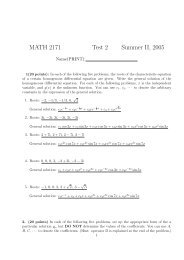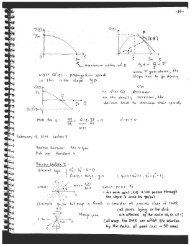fourth order chebyshev methods with recurrence relation
fourth order chebyshev methods with recurrence relation
fourth order chebyshev methods with recurrence relation
You also want an ePaper? Increase the reach of your titles
YUMPU automatically turns print PDFs into web optimized ePapers that Google loves.
2046 ASSYR ABDULLE<br />
0<br />
c2<br />
.<br />
a21<br />
.<br />
. ..<br />
cs−4 as−4,1 ... as−4,s−5<br />
<br />
bi b1 ... bs−3 <br />
bi + c2<br />
b1 ... bs−3 .<br />
<br />
bi + c4<br />
.<br />
b1 ... bs−3<br />
b1 ... bs−3<br />
bs−4<br />
bs−4 a21<br />
. ..<br />
bs−4 a41 ... a43<br />
bs−4<br />
Fig. 3.2. Tableau of method WP.<br />
b1 ... b3<br />
The second and the “composite” <strong>methods</strong>. For the method W we take a<br />
<strong>fourth</strong> stage method (right tableau of Figure 3.1) so that the composite method WP is<br />
given by Figure 3.2. In the tableau of method WP, we will denote by ci the elements<br />
of the first column, by aij the elements of the “triangle,” and by bi the elements of<br />
the last row. The <strong>order</strong> conditions of the method WP are the usual ones for <strong>order</strong> 4:<br />
(3.9)<br />
wp( ) = bi = 1,<br />
wp( / ) = 2 biaij = 1,<br />
wp( \ /<br />
) = 3 wp( /<br />
biaijaik = 1,<br />
\<br />
<br />
<br />
) =<br />
<br />
6 biaijajk = 1,<br />
wp( \ |/ <br />
) = 4 wp( /<br />
biaijaikail = 1,<br />
\<br />
<br />
<br />
\ ) = 8 wp( /<br />
biaijajkail = 1,<br />
\/<br />
<br />
) = 12 wp( /<br />
biaijajkajl = 1,<br />
\<br />
<br />
/ <br />
) = 24 biaijajkakl = 1.<br />
Here we used the trees notation (connected graphs <strong>with</strong>out cycles and a distinguished<br />
vertex) for the elementary weights (wp(...)) involved in the <strong>order</strong> conditions (see [6,<br />
pp. 145–154] or [3]).<br />
Theorem 12.6 of [6, p. 267] can be used to express the <strong>order</strong> conditions of the<br />
method WP in function of the two sub<strong>methods</strong>, W and P . See also [5] for a new<br />
simple proof of this latter theorem (<strong>with</strong> another normalization for the elementary<br />
weights). We obtain<br />
wp( ) = w( )+p( ),<br />
wp( / ) = w( / )+2w( )p( )+p( / ),<br />
wp( \ /<br />
) = w( \ /<br />
)+3w( / )p( )+3w( )p( ) 2 + p( \ /<br />
wp( /<br />
),<br />
\<br />
<br />
<br />
) =<br />
\<br />
w( / <br />
<br />
)+3w( / )p( )+3w( )p( / )+p( / \<br />
<br />
<br />
),<br />
wp( \ |/ <br />
) = w( \ |/ <br />
)+4w( \ /<br />
)p( )+6w( / )p( ) 2 +4w( )p( ) 3 + p( \ |/ <br />
),<br />
b4


